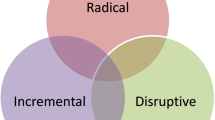Abstract
Innovation in services is one of the prime drivers of several economies. There are various schools of thought that have emerged over the past few decades in this area. The present paper focuses on the evolution of the ‘synthesis’ school of thought. It contributes to literature by extending the framework proposed by Lancaster (The Journal of Political Economy, 74(2), 132–157, 1966) and other researchers by incorporating aspects of Web 2.0 technology with a specific reference to e-learning. The proposed framework is validated using case study from the field of e-learning.




Similar content being viewed by others
Notes
This program is an initiative by the Ministry of Human Resource Development under the National Mission on Education through ICT. Details available at co-learn.in/
A-VIEW Classroom is a framework that provides a rich interactive social environment for e-learning
Additional details regarding A-VIEW can be obtained from www.aview.in
A-VIEW, developed by Amrita University, is part of Talk to a Teacher program led by IIT Bombay and funded by NME-ICT, MHRD. (Source : http://www.aview.in/)
References
Anderson, T. (2005). Distance learning – Social software’s killer ap? Retrieved 2012, from citeseerx: http://citeseerx.ist.psu.edu/viewdoc/download?doi=10.1.1.95.630&rep=rep1&type=pdf
Anderson, P., Hepworth, M., Kelly, B., & Metcalfe, R. (2007). What is Web 2.0? Ideas, technologies and implications for education by. In: M. Hepworth, B. Kelly, R. Metcalfe, & L. Phipps, (Eds.)Technology, 60(1), 64. Citeseer. Retrieved from http://www.jisc.ac.uk/media/documents/techwatch/tsw0701b.pdf
Awodele, O., Idowu, S., Anjorin, O., Adedire, A., & Akpore, V. (2009). University enhancement system using a social networking approach: Extending E-learning. Issues in Informing Science and Information Technology, 6.
Brown, J. S., & Adler, R. P. (2008). Minds on fire: Open education, the long tail, and learning 2.0. Educause Review, 43(1), 16–32. Educause. Retrieved from http://connect.educause.edu/Library/EDUCAUSE+Review/MindsonFireOpenEducationt/45823?time=1220007552
Coombs, R., & Miles, I. (2000). Innovation, measurement and services. In J. S. Metcalfe & I. Miles (Eds.), Innovation systems in the service economy (Measurement and case study analysis, pp. 85–103). Boston: Kluwer.
Davidow, W. H., & Malone, M. S. (1992). The Virtual Corporation. New York: Harper-Collins.
DeVries, E. I. (2006). Innovation in services in networks of organizations and in the distribution of services. Research Policy, 35, 1037–1051.
Drejer, I. (2004). Identifying innovation in surveys of services: a Schumpeterian perspective. Research Policy, 33, 551–562.
Gadrey, J., Gallouj, F., & Weinstein, O. (1995). New modes of innovation: how services benefit industry. International Journal of Service Industry Management, 6(3), 4–16.
Gallouj, F. (1998). Innovating in reverse: services and the reverse product cycle. European Journal of Innovation Management, 1(3), 123–138.
Gallouj, F. (2002). Innovation in services and the attendant old and new myths. The Journal of Socio-Economics, 31, 137–154.
Gallouj, F., & Weinstein, O. (1997). Innovation in services. Research Policy, 26, 537–556.
Hannafin, M., Land, S., & Oliver, K. (1999). Open learning environments: Foundations, methods, and models. In C. M. Reigeluth (Ed.), Instructional-design theories and models: Education technology research and development, 2, 215–239
Henderson, R. M., & Clark, K. B. (1990). Architectural innovation: the reconfiguration of existing product technologies and the failure of established firms. Administrative Science Quarterly, 35, 9–30.
Lancaster, K. (1966). A new approach to consumer theory. The Journal of Political Economy, 74(2), 132–157.
McLoughlin, C. & Lee, M. J. W. (2007). Social software and participatory learning: Pedagogical choices with technology affordances in the Web 2.0 era. In ICT: Providing choices for learners and learning. Proceedings ascilite Singapore 2007. http://www.ascilite.org.au/conferences/singapore07/procs/mcloughlin.pdf
Mowshowitz, A. (1997). Virtual organization. Communications of the ACM, 40(9), 30–37.
Osterle, H., Fleisch, E., & Alt, R. (2001). Business Networking: Shaping collaboration between enterprises. Berlin: Springer Verlag.
Phukan, R. (2014). Skill India programme – Objectives, features & advantages. Retrieved July 2015, from http://www.mapsofindia.com: http://www.mapsofindia.com/my-india/society/skill-india-a-new-programme-to-be-launched-in-march-2015
Powell, W. W. (1990). Neither market nor hierarchy: network forms of organization. Research in Organization Behavior, 12, 295–336.
Quelin, B. (1997). Appropriability and creation of new capabilities through strategic alliances. In R. Sanchez & H. Heene (Eds.), Strategic learning and knowledge management. London: Wiley.
Saviotti, P., & Metcalfe, J. (1984). A theoritical approach to the construction of technological output indicators. Research Policy, 13(3), 141–151.
Sundbo, J. (1997). Management of innovation in services. The Service Industries Journal, 17(3), 432–455.
Sundbo, J. (2001). The strategic management of innovation: A sociological and economic theory. Cheltenham: Edward Elgar.
The Hindu. (2015). Maharashtra govt. uses Amrita software to train teachers. Retrieved July 2015, from The Hindu Web site: http://www.thehindu.com/news/cities/Coimbatore/maharashtra-govt-uses-amrita-software-to-train-teachers/article7191716.ece
Van der Aa, W., & Elfring, T. (2002). Realizing innovation in services. Scandinavian Journal of Management, 18(2), 155–171.
Author information
Authors and Affiliations
Corresponding author
Rights and permissions
About this article
Cite this article
Shivdas, P.A., Sivakumar, S. Innovation in services: A lancastrian approach to the field of e-learning. Educ Inf Technol 21, 1913–1925 (2016). https://doi.org/10.1007/s10639-015-9427-z
Published:
Issue Date:
DOI: https://doi.org/10.1007/s10639-015-9427-z
Keywords
- Innovation in services
- Recombinative innovation
- Lancaster approach
- e-learning
- Synthesis approach
- Web 2.0 technology
- Peer-peer learning




